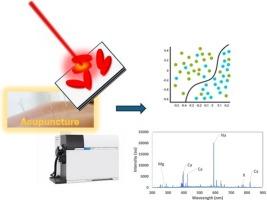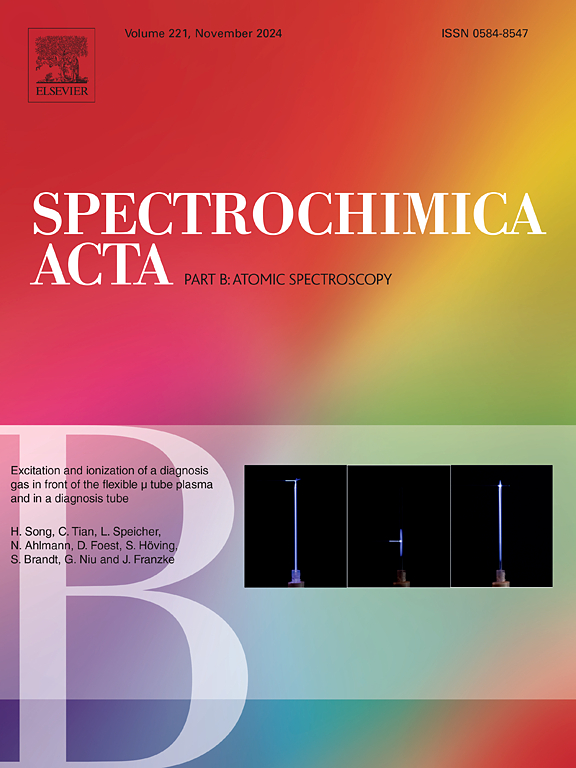Assessment of acupuncture's effectiveness in treating gulf war illness using laser induced breakdown spectroscopy and inductively coupled plasma mass spectrometry
IF 3.8
2区 化学
Q1 SPECTROSCOPY
引用次数: 0
Abstract
In an effort to contribute to define whether Gulf War Illness (GWI) has physiological aspects, we evaluated the effectiveness of acupuncture treatment by measuring blood plasma metal levels and comparing them to the McGill pain scores of 22 patients. We analyzed the blood plasma samples of 22 GWI patients who underwent 2 acupuncture treatments per week. We analyzed the blood metal levels of these patients at baseline and after 2 and 4 months of treatment with acupuncture using laser-induced breakdown spectroscopy (LIBS). Principal component analysis (PCA) loadings of the LIBS data revealed that emission lines of sodium, potassium, magnesium, and calcium were key features differentiating the two types of blood plasma samples. We also conducted inductively coupled plasma mass spectrometry (ICP-MS) measurements on the same samples and compared the findings to the McGill pain scores of the patients. Levels of sodium, potassium, magnesium, phosphorus, iron, copper, and zinc for all 22 patients were measured using ICP-MS. We observed after 2 and 4 months of acupuncture treatment, the Pearson correlation coefficient of the McGill pain score and the concentrations of phosphorus (P), and zinc (Zn), exhibit a moderate positive correlation with changes in the McGill pain score, with Pearson correlation coefficients of 47 % (p = 0.026) for the 0–2-month period, 45 % (p = 0.038) for the 0–4-month period, and 42 % (p = 0.05) for the 0–2-month period, respectively. Sodium (Na) exhibits a nearly moderate correlation, with a Pearson coefficient of 39 % and a p-value of 0.07. Our result suggests a potential link between element concentrations, acupuncture treatment and pain response.

利用激光诱导击穿光谱法和电感耦合等离子体质谱法评估针灸治疗海湾战争疾病的效果
为了帮助确定海湾战争疾病(GWI)是否与生理因素有关,我们通过测量血浆金属水平并将其与 22 名患者的麦吉尔疼痛评分进行比较,评估了针灸治疗的效果。我们分析了 22 名每周接受 2 次针灸治疗的 GWI 患者的血浆样本。我们使用激光诱导击穿光谱法(LIBS)分析了这些患者在基线以及接受针灸治疗 2 个月和 4 个月后的血液金属含量。激光诱导击穿光谱数据的主成分分析(PCA)载荷显示,钠、钾、镁和钙的发射线是区分两种血浆样本的关键特征。我们还对相同的样本进行了电感耦合等离子体质谱(ICP-MS)测量,并将测量结果与患者的麦吉尔疼痛评分进行了比较。我们使用 ICP-MS 测量了所有 22 名患者体内钠、钾、镁、磷、铁、铜和锌的含量。我们观察到,针灸治疗 2 个月和 4 个月后,麦吉尔疼痛评分与磷(P)和锌(Zn)浓度的皮尔逊相关系数与麦吉尔疼痛评分的变化呈中度正相关,0-2 个月的皮尔逊相关系数为 47 %(P = 0.0-2个月的皮尔逊相关系数分别为 47% (p = 0.026),0-4个月的皮尔逊相关系数分别为 45% (p = 0.038),0-2个月的皮尔逊相关系数分别为 42% (p = 0.05)。钠(Na)的相关性接近中等,皮尔逊系数为 39%,p 值为 0.07。我们的研究结果表明,元素浓度、针灸治疗和疼痛反应之间存在潜在联系。
本文章由计算机程序翻译,如有差异,请以英文原文为准。
求助全文
约1分钟内获得全文
求助全文
来源期刊
CiteScore
6.10
自引率
12.10%
发文量
173
审稿时长
81 days
期刊介绍:
Spectrochimica Acta Part B: Atomic Spectroscopy, is intended for the rapid publication of both original work and reviews in the following fields:
Atomic Emission (AES), Atomic Absorption (AAS) and Atomic Fluorescence (AFS) spectroscopy;
Mass Spectrometry (MS) for inorganic analysis covering Spark Source (SS-MS), Inductively Coupled Plasma (ICP-MS), Glow Discharge (GD-MS), and Secondary Ion Mass Spectrometry (SIMS).
Laser induced atomic spectroscopy for inorganic analysis, including non-linear optical laser spectroscopy, covering Laser Enhanced Ionization (LEI), Laser Induced Fluorescence (LIF), Resonance Ionization Spectroscopy (RIS) and Resonance Ionization Mass Spectrometry (RIMS); Laser Induced Breakdown Spectroscopy (LIBS); Cavity Ringdown Spectroscopy (CRDS), Laser Ablation Inductively Coupled Plasma Atomic Emission Spectroscopy (LA-ICP-AES) and Laser Ablation Inductively Coupled Plasma Mass Spectrometry (LA-ICP-MS).
X-ray spectrometry, X-ray Optics and Microanalysis, including X-ray fluorescence spectrometry (XRF) and related techniques, in particular Total-reflection X-ray Fluorescence Spectrometry (TXRF), and Synchrotron Radiation-excited Total reflection XRF (SR-TXRF).
Manuscripts dealing with (i) fundamentals, (ii) methodology development, (iii)instrumentation, and (iv) applications, can be submitted for publication.

 求助内容:
求助内容: 应助结果提醒方式:
应助结果提醒方式:


